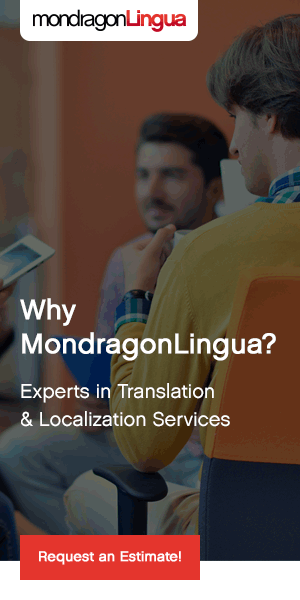The mantra “Think Globally, Act Locally” resonates strongly in the Travel, Leisure and Hospitality industries. Especially when it comes to translation. In this article, we’ll explore some of the challenges and solutions.
Translation ‘bloopers’ are amusing. Tales abound of restaurants offering “Irritable Scalloped Kidney” or “Demonic Steak”. (Check out Travel and Leisure for more.)
It’s one thing for a small, local restaurant to make a mistake. But even large, experienced organizations can stumble: witness the story about the soft drink campaign in China where their tagline “The Drink that refreshes” was translated as “Dig up the bones of your ancestors”.
In another case, a major bank had to launch a $10 million re-branding campaign to repair the damage done when its catchphrase “Assume Nothing” was mistranslated as “Do Nothing” in various countries.
For the hospitality industry, translation and localization are vital. Travelers without language skills depend upon the sanctuary of hotels, car rental agencies and airlines to ease the anxiety of being in unfamiliar places. We expect the staff to speak our language and guide us through the myriad complexities of local cultures.
But how do you convey the complexities of Basque cuisine in English? Or describe the local customs of driving in Boston to a car-rental customer from Russia? For the hospitality provider, the challenge is to understand the nuances of how different nationalities prefer to do business with them. Let’s take a deeper look:
First: the customer experience when booking their trip. Travelers expect to book and pay in their own currency. Americans prefer shopping on multiple sites, booking separate deals for different parts of their journey. For myself, there’s a lingering suspicion that I’ll get a better deal or better service if I book things this way, despite the extra effort. But Europeans prefer to book their travel all at once, as a package, on a single site. Facilitating these different customer journeys is key: have links to approved vendors providing adjacent services and make it possible to keep the customer within your own site.
Your website is the first gateway into your business that the foreign traveler will experience, and it must function flawlessly in every major language. It cannot inadvertently cause social or cultural offense, be it through the wording you use, the colors or images on the site, or the way in which currencies, dates and measurements are used.
Then, once the traveler is in your actual locale, can they still access the site in their language? How difficult is it for the non-native speaker to find help while on your site? The rise of Chat gives rise to the need for real-time translation. How to provide this without the added cost of on-demand interpreters? How to find the right ‘voice’ to make your customers feel welcome?
Second, the in-house literature such as menus, itineraries, in-room directories, maps, rental information and safety instructions should all be available in many different languages in order to cater to the world audience that the company will be trying to attract.
Success in this effort means addressing it on multiple fronts.
SEO and SEM, keywords and topic clusters, all must be attended to with a kind of borderline fanaticism as we strive to master the complexities of digital marketing. And what about travelers searching for your services in countries outside of the Googleplex like China, where Baidu presides over an even larger number of ever-more affluent consumers?
But hospitality companies are still doing it. Many of them succeed. What’s their secret?
- Partnering with the right Language Services Provider (LSP) for one. Making sure that partner produces accurate and high-quality translation that works within the parameters of your site and your software, leveraging language assets such as Translation Memories (TMs) for maximum cost-efficiency, speed and quality.
- Using your assets on the ground: the people you have in place at your hotels, in your rental agencies, in your restaurant. Nobody understands the local culture and idioms like your own staff. However, they have their day jobs to do. It used to be that the first place you could turn to for translation were the folks at the front desk or back-office, but now the demands of translation have moved beyond their abilities. It’s neither fair nor effective to rely upon them.
- Where they can be used, very effectively however, is in working closely with the language services provider to review translated content: ensuring it is properly aligned with local culture and values. This has the effect of not only ensuring accuracy but providing a feedback loop to the LSP so that the original translation is continually improving, that TM’s are getting updated, that new keywords are being harvested.
- Regarding Chat, there are ever-more robust suites of tools your LSP can use to assist clients looking for instant answers. In a lot of cases, a customer in, for example, Italy, can type a question into the Chat window which instantly recognizes that the customer is speaking Italian, get translated in real-time to the English-speaking rep in New York. The rep responds in English, the answer is instantly translated into Italian, or French, or Brazilian Portuguese and presto! the customer is conversing easily in their native tongue.
- It’s important that the LSP is not merely translating, but also transcreating, including sure your translator doesn’t just translate words, but can also include appropriate cultural references and the nuances that will give international visitors that welcoming feeling. Transcreation will help surmount the language barrier.
- Finally, there is a tremendous amount of cost-saving on translations to be achieved when the source content is optimized for translation before it’s sent to the LSP. Harnessing the power or terminology banks and style guides, for example, improves quality and reduces the time spent in review. And there are software tools that incorporate natural-language processing algorithms to ensure that the original content hews closely to these rules.
Your LSP should also be able to provide translators with solid domain-expertise. That means somebody who understands food, or local architecture, or customs and immigration questions, translators who not only speak the language natively, but know the locale. A good LSP will organize project managers and translators to provide the best mix of skills needed.
Machine translation helps enormously with cost and speed. But care should be exercised here as well: make certain you have a strong post-edit team, either within your own ranks or through the LSP, so that customers cannot distinguish between the Machine and the Real Thing.
And one last word: make sure your LSP has deep domain experience in your industry. Otherwise we’ll all be digging up the bones of our ancestors and wondering what the hell went wrong.
For more information on how MondragonLingua helps clients in Hospitality and other industries, contact us.







